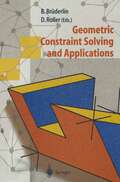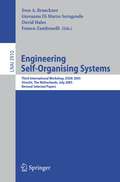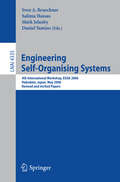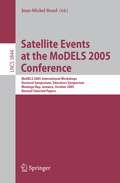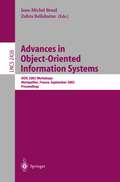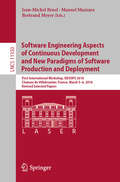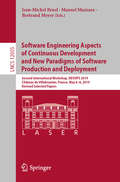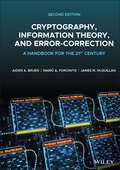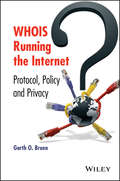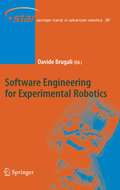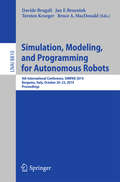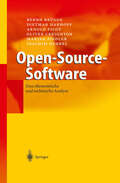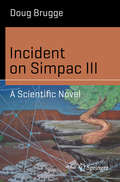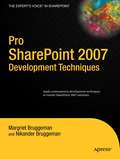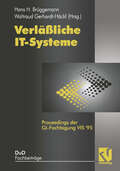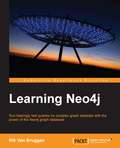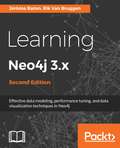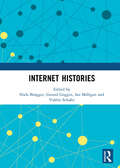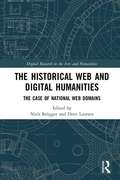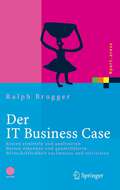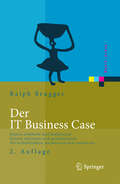- Table View
- List View
Geometric Constraint Solving and Applications
by Beat Brüderlin Dieter RollerGeometric constraint programming increases flexibility in CAD design specifications and leads to new conceptual design paradigms.This volume features a collection of work by leading researchers developing the various aspects of constraint-based product modeling.In an introductory chapter the role of constraints in CAD systems of the future and their implications for the STEP data exchange format are discussed. The main part of the book deals with the application of constraints to conceptual and collaborative design, as well as state-of-the-art mathematical and algorithmic methods for constraint solving.
Engineering Self-Organising Systems: Third International Workshop, ESOA 2005, Utrecht, The Netherlands, July 25, 2005, Revised Selected Papers (Lecture Notes in Computer Science #3910)
by Sven A. Brueckner Giovanni Di Marzo Serugendo David HalesThis book constitutes the refereed post-proceedings of the Third International Workshop on Engineering Self-Organising Applications, ESOA 2005, held in July 2005 as an associated event of AAMAS 2005. The 12 revised full papers and 6 revised short papers presented are organized in topical sections on novel self-organising mechanisms, methodologies, models and tools for self-organising applications, and specific applications of self-organising mechanisms.
Engineering Self-Organising Systems: 4th International Workshop, ESOA 2006, Hakodate, Japan, May 9, 2006, Revised and Invited Papers (Lecture Notes in Computer Science #4335)
by Sven Brueckner Salima Hassas Mark Jelasity Daniel YaminsThis book constitutes the thoroughly refereed post-proceedings of the 4th International Workshop on Engineering Self-Organising Applications, ESOA 2006, held in Hakodate, Japan in May 2006. This was an associated event of AAMAS 2006, the 5th International Joint Conference on Autonomous Agents and Multi-Agent Systems. The seven full papers presented together with six invited papers were carefully selected for inclusion in the book.
Satellite Events at the MoDELS 2005 Conference: MoDELS 2005 International Workshop OCLWS, MoDeVA, MARTES, AOM, MTiP, WiSME, MODAUI, Nfc, MDD, WUsCaM, Montego Bay, Jamaica, October 2-7, 2005, Revised Selected Papers (Lecture Notes in Computer Science #3844)
by Jean-Michel BruelThe 30 revised full papers were carefully selected for inclusion in the book and are presented along with an educators's and a doctorial symposium section comprising additional 13 short articles. The papers are organized in topical sections representing the various workshops
Advances in Object-Oriented Information Systems: OOIS 2002 Workshops, Montpellier, France, September 2, 2002 Proceedings (Lecture Notes in Computer Science #2426)
by Jean-Michel Bruel Zohra BellahseneFor the ?rst time four workshops have been held in conjunction with the 8th Object-Oriented Information Systems conference, OOIS 2002, to encourage - teraction between researchers and practitioners. Workshop topics are, of course, inline with the conference’s scienti?c scope and provide a forum for groups of researchers and practitioners to meet together more closely and to exchange opinions and advanced ideas, and to share preliminary results on focused issues in an atmosphere that fosters interaction and problem solving. The conference hosted four one-day workshops. The four selected workshops were fully in the spirit of a workshop session hosted by a main conference. Indeed, OOIS deals with all the topics related to the use of object-oriented techniques for the development of information systems. The four workshops are very speci?c and contribute to enlarging the spectrum of the more general topics treated in the main conference. The ?rst workshop focused on a very speci?c and key c- cept of object-oriented development, the specialization/generalization hierarchy. The second one explored the use of “non-traditional” approaches (at the edge of object-oriented techniques, such as aspects, AI, etc.) to improve reuse. The third workshop dealt with optimization in Web-based information systems. And ?nally the fourth workshop investigated issues related to model-driven software development.
Software Engineering Aspects of Continuous Development and New Paradigms of Software Production and Deployment: First International Workshop, DEVOPS 2018, Chateau de Villebrumier, France, March 5-6, 2018, Revised Selected Papers (Lecture Notes in Computer Science #11350)
by Jean-Michel Bruel Manuel Mazzara Bertrand MeyerThis book constitutes revised selected papers from the First International Workshop on Software Engineering Aspects of Continuous Development and New Paradigms of Software Production and Deployment, DEVOPS 2018, hled at the hateau de Villebrumier, France, in March 2018. The 17 papers presented in this volume were carefully reviewed and selected from 23 submissions. They cover a wide range of problems arising from Devops and related approaches, current tools, rapid development-deployment processes, effects on team performance, analytics, trustworthiness, microservices and related topics.
Software Engineering Aspects of Continuous Development and New Paradigms of Software Production and Deployment: Second International Workshop, DEVOPS 2019, Château de Villebrumier, France, May 6–8, 2019, Revised Selected Papers (Lecture Notes in Computer Science #12055)
by Jean-Michel Bruel Manuel Mazzara Bertrand MeyerThis book constitutes revised selected papers of the Second International Workshop on Software Engineering Aspects of Continuous Development and New Paradigms of Software Production and Deployment, DEVOPS 2019, held at the Château de Villebrumier, France, in May 2019.The 15 papers presented in this volume were carefully reviewed and selected from 19 submissions. They cover a wide range of problems arising from DevOps and related approaches: current tools, rapid development-deployment processes, modeling frameworks, anomaly detection in software releases, DevDataOps, microservices, and related topics.
Cryptography, Information Theory, and Error-Correction: A Handbook for the 21st Century (Wiley Series In Discrete Mathematics And Optimization Ser. #68)
by Aiden A. Bruen Mario A. Forcinito James M. McQuillanCRYPTOGRAPHY, INFORMATION THEORY, AND ERROR-CORRECTION A rich examination of the technologies supporting secure digital information transfers from respected leaders in the fieldAs technology continues to evolve Cryptography, Information Theory, and Error-Correction: A Handbook for the 21ST Century is an indispensable resource for anyone interested in the secure exchange of financial information. Identity theft, cybercrime, and other security issues have taken center stage as information becomes easier to access. Three disciplines offer solutions to these digital challenges: cryptography, information theory, and error-correction, all of which are addressed in this book.This book is geared toward a broad audience. It is an excellent reference for both graduate and undergraduate students of mathematics, computer science, cybersecurity, and engineering. It is also an authoritative overview for professionals working at financial institutions, law firms, and governments who need up-to-date information to make critical decisions. The book’s discussions will be of interest to those involved in blockchains as well as those working in companies developing and applying security for new products, like self-driving cars. With its reader-friendly style and interdisciplinary emphasis this book serves as both an ideal teaching text and a tool for self-learning for IT professionals, statisticians, mathematicians, computer scientists, electrical engineers, and entrepreneurs.Six new chapters cover current topics like Internet of Things security, new identities in information theory, blockchains, cryptocurrency, compression, cloud computing and storage. Increased security and applicable research in elliptic curve cryptography are also featured. The book also:Shares vital, new research in the field of information theoryProvides quantum cryptography updatesIncludes over 350 worked examples and problems for greater understanding of ideas.Cryptography, Information Theory, and Error-Correction guides readers in their understanding of reliable tools that can be used to store or transmit digital information safely.
Cryptography, Information Theory, and Error-Correction: A Handbook for the 21st Century
by Aiden A. Bruen Mario A. Forcinito James M. McQuillanCRYPTOGRAPHY, INFORMATION THEORY, AND ERROR-CORRECTION A rich examination of the technologies supporting secure digital information transfers from respected leaders in the fieldAs technology continues to evolve Cryptography, Information Theory, and Error-Correction: A Handbook for the 21ST Century is an indispensable resource for anyone interested in the secure exchange of financial information. Identity theft, cybercrime, and other security issues have taken center stage as information becomes easier to access. Three disciplines offer solutions to these digital challenges: cryptography, information theory, and error-correction, all of which are addressed in this book.This book is geared toward a broad audience. It is an excellent reference for both graduate and undergraduate students of mathematics, computer science, cybersecurity, and engineering. It is also an authoritative overview for professionals working at financial institutions, law firms, and governments who need up-to-date information to make critical decisions. The book’s discussions will be of interest to those involved in blockchains as well as those working in companies developing and applying security for new products, like self-driving cars. With its reader-friendly style and interdisciplinary emphasis this book serves as both an ideal teaching text and a tool for self-learning for IT professionals, statisticians, mathematicians, computer scientists, electrical engineers, and entrepreneurs.Six new chapters cover current topics like Internet of Things security, new identities in information theory, blockchains, cryptocurrency, compression, cloud computing and storage. Increased security and applicable research in elliptic curve cryptography are also featured. The book also:Shares vital, new research in the field of information theoryProvides quantum cryptography updatesIncludes over 350 worked examples and problems for greater understanding of ideas.Cryptography, Information Theory, and Error-Correction guides readers in their understanding of reliable tools that can be used to store or transmit digital information safely.
WHOIS Running the Internet: Protocol, Policy, and Privacy
by Garth O. BruenDiscusses the evolution of WHOIS and how policy changes will affect WHOIS’ place in IT today and in the futureThis book provides a comprehensive overview of WHOIS. The text begins with an introduction to WHOIS and an in-depth coverage of its forty-year history. Afterwards it examines how to use WHOIS and how WHOIS fits in the overall structure of the Domain Name System (DNS). Other technical topics covered include WHOIS query code and WHOIS server details. The book also discusses current policy developments and implementations, reviews critical policy documents, and explains how they will affect the future of the Internet and WHOIS. Additional resources and content updates will be provided through a supplementary website. Includes an appendix with information on current and authoritative WHOIS services around the world Provides illustrations of actual WHOIS records and screenshots of web-based WHOIS query interfaces with instructions for navigating them Explains network dependencies and processes related to WHOIS utilizing flowcharts Contains advanced coding for programmers Visit the book's companion website http://whois.knujon.com for technical and policy documents concerning WHOIS, WHOIS code examples, internet locations for WHOIS databases and more. WHOIS Running the Internet: Protocol, Policy, and Privacy is written primarily for internet developers, policy developers, industry professionals in law enforcement, digital forensic investigators, and intellectual property attorneys.Garth O. Bruen is an Internet policy and security researcher whose work has been published in the Wall Street Journal and the Washington Post. Since 2012 Garth Bruen has served as the North American At-Large Chair to the Internet Corporation of Assigned Names and Numbers (ICANN). In 2003 Bruen created KnujOn.com with his late father, Dr. Robert Bruen, to process and investigate Internet abuse complaints (SPAM) from consumers. Bruen has trained and advised law enforcement at the federal and local levels on malicious use of the Domain Name System in the way it relates to the WHOIS record system. He has presented multiple times to the High Technology Crime Investigation Association (HTCIA) as well as other cybercrime venues including the Anti-Phishing Working Group (APWG) and the National Center for Justice and the Rule of Law at The University of Mississippi School of Law. Bruen also teaches the Fisher College Criminal Justice School in Boston where he develops new approaches to digital crime.
WHOIS Running the Internet: Protocol, Policy, and Privacy
by Garth O. BruenDiscusses the evolution of WHOIS and how policy changes will affect WHOIS’ place in IT today and in the futureThis book provides a comprehensive overview of WHOIS. The text begins with an introduction to WHOIS and an in-depth coverage of its forty-year history. Afterwards it examines how to use WHOIS and how WHOIS fits in the overall structure of the Domain Name System (DNS). Other technical topics covered include WHOIS query code and WHOIS server details. The book also discusses current policy developments and implementations, reviews critical policy documents, and explains how they will affect the future of the Internet and WHOIS. Additional resources and content updates will be provided through a supplementary website. Includes an appendix with information on current and authoritative WHOIS services around the world Provides illustrations of actual WHOIS records and screenshots of web-based WHOIS query interfaces with instructions for navigating them Explains network dependencies and processes related to WHOIS utilizing flowcharts Contains advanced coding for programmers Visit the book's companion website http://whois.knujon.com for technical and policy documents concerning WHOIS, WHOIS code examples, internet locations for WHOIS databases and more. WHOIS Running the Internet: Protocol, Policy, and Privacy is written primarily for internet developers, policy developers, industry professionals in law enforcement, digital forensic investigators, and intellectual property attorneys.Garth O. Bruen is an Internet policy and security researcher whose work has been published in the Wall Street Journal and the Washington Post. Since 2012 Garth Bruen has served as the North American At-Large Chair to the Internet Corporation of Assigned Names and Numbers (ICANN). In 2003 Bruen created KnujOn.com with his late father, Dr. Robert Bruen, to process and investigate Internet abuse complaints (SPAM) from consumers. Bruen has trained and advised law enforcement at the federal and local levels on malicious use of the Domain Name System in the way it relates to the WHOIS record system. He has presented multiple times to the High Technology Crime Investigation Association (HTCIA) as well as other cybercrime venues including the Anti-Phishing Working Group (APWG) and the National Center for Justice and the Rule of Law at The University of Mississippi School of Law. Bruen also teaches the Fisher College Criminal Justice School in Boston where he develops new approaches to digital crime.
Software Engineering for Experimental Robotics (Springer Tracts in Advanced Robotics #30)
by Davide BrugaliThis book reports on the concepts and ideas discussed at the well attended ICRA2005 Workshop on "Principles and Practice of Software Development in Robotics", held in Barcelona, Spain, April 18 2005. It collects contributions that describe the state of the art in software development for the Robotics domain. It also reports a number of practical applications to real systems and discuss possible future developments.
Simulation, Modeling, and Programming for Autonomous Robots: 4th International Conference, SIMPAR 2014, Bergamo, Italy, October 20-23, 2014. Proceedings (Lecture Notes in Computer Science #8810)
by Davide Brugali Jan Broenink Torsten Kroeger Bruce MacDonaldThis book constitutes the refereed proceedings of the 4th International Conference on Simulation, Modeling, and Programming for Autonomous Robots, SIMPAR 2014, held in Bergamo, Italy, in October 2014. The 49 revised full papers presented were carefully reviewed and selected from 62 submissions. The papers are organized in topical sections on simulation, modeling, programming, architectures, methods and tools, and systems and applications.
Open-Source-Software: Eine ökonomische und technische Analyse
by Bernd Brügge Dietmar Harhoff Arnold Picot Oliver Creighton Marina Fiedler Joachim HenkelDas Buch bietet für den deutschsprachigen Bereich erstmals eine wirtschaftliche und technische Betrachtung und Analyse eines immer wichtiger werdenden Modells der Softwareentwicklung und -lizenzierung. Es gibt zunächst eine Übersicht über den deutschen Softwaremarkt, stellt dann die verschiedenen Erscheinungsformen von Open-Source-Software (OSS) dar, beleuchtet die technischen Aspekte der Erstellung und des Einsatzes von OSS und analysiert sowohl die Motivation von Privatpersonen als auch von Unternehmen OSS zu entwickeln und einzusetzen. Insbesondere werden auch die wettbewerbsstrategischen und die betriebswirtschaftlichen Dimensionen dieser sich rasch ausbreitenden Vorgehensweise erörtert. Darauf aufbauend werden die wirtschaftlichen Auswirkungen von OSS auf die deutsche Softwareindustrie sowie wirtschaftspolitische Aspekte von OSS untersucht.
Incident on Simpac III: A Scientific Novel (Science and Fiction)
by Doug BruggeA few hundred years into the future, a wave of space colonization follows a disastrous earlier attempt to inhabit nearby extrasolar planets. It is guided by a new computational method based on massive data-driven socio-cultural and socio-epidemiological modeling and using novel biological computers, fed with data on Earth’s history of successes and failures. Yet, in the newly settled Simpac system, some unexpected and worrying anomalies begin cropping up, making an urgent expedition to the system necessary: is it the underlying data, the computations, or is some unknown entity tampering with the space colonization program? A race against time ensues as the lives of four strangers begin to converge. While grounded in the social systems aspect, the author posits that the future is likely to be characterized by more biology-based tools than most contemporary science fiction – which most often relies entirely on non-biological hardware in terms of advanced technologies – predicts. The result is an entertaining and skillful blend of thriller and SF, complemented by a nontechnical appendix describing the underlying science.
Pro SharePoint 2007 Development Techniques
by Nikander BruggemanA hugely practical and up-to-date work, this book is for developers looking to combine the latest advances in Windows and Microsoft development, such as .NET 2.0, ASP.NET AJAX, InfoPath, and Biztalk, with their SharePoint sites. SharePoint is a hot topic right now, and mixing the intersection of one hot tech area with other hot techs is sure to be a hit. This is the only book on the market dedicated to using other products and technologies with SharePoint. Nikander and Margriet Bruggeman are .NET professionals specializing in building web applications using the latest Microsoft technology. Their work includes software design, development, consulting and training.
Objektorientierte und verteilte Lösung von Optimierungsproblemen (Beiträge zur Wirtschaftsinformatik #25)
by Frank Josef BrüggemannReale Optimierungsprobleme erfordern die Berechnung hochkomplexer Computermodelle. Die dazu notwendige Rechenleistung kann kostengünstig durch Workstation-Cluster bereitgestellt werden, die die Leistungsfähigkeit von Mini-Supercomputern erreichen und oft nur zu einem geringen Teil ausgelastet sind. Im Buch wird auf Basis von OMT ein objektorientierter Ansatz für die verteilte Lösung von Optimierungsproblemen entwickelt und in ein Prototyp-System umgesetzt. Der in C++ implementierte Prototyp verfügt über eine graphische Oberfläche zur Steuerung der Optimierungsrechnung und zeigt, wie existierende Softwarepakete aus Fortran oder C in die verteilte Berechnung integriert werden können.
Verläßliche IT-Systeme: Proceedings der GI-Fachtagung VIS ’95 (DuD-Fachbeiträge)
by Hans H. Brüggemann Waltraud Gerhardt-HäcklInformationstechnische Systeme sind heute aus dem Leben nicht mehr wegzudenken. In relativ kurzer Zeit und in unterschiedlichsten Lebensbereichen hat der Gebrauch von IT-Systemen zu Abhängigkeiten zwischen diesen Systemen und dem erwarteten Funktionieren der automatisierten Prozesse geführt. Diese Wechselwirkungen sind verschieden groß, abhängig von den Eigenschaften des betreffenden IT-Systems, der Umgebung des IT-Systems sowie der Art und Intensität seines Gebrauchs. Ein Bewertungsmaßstab, den insbesondere Benutzer und Betreiber eines IT Systems an die erwartungsgemäße Unterstützung der automatisierten Prozesse anlegen, wird durch den Begriff Verläßlichkeit charakterisiert. Verläßlichkeit umfaßt ein Bündel von Systemeigenschaften, die über die klassischen Sicherheitsanforderungen der Verfügbarkeit, Integrität und Vertraulichkeit hinausgehen. Hinzu treten mindestens noch Forderungen bezüglich der Durchschaubarkeit der Wirkungen einer Benutzer-Aktion und umgekehrt der Rückverfolgbarkeit einer Wirkung zu den auslösenden Aktionen und Personen. Ein umfassendes Kriterium ist die Verantwortbarkeit der Nutzung eines IT Systems unter verschiedenen Aspekten wie z.B. der Wahrung von Persönlichkeitsrechten, sicherheitstechnischer Anforderungen oder der Realisierung von Unternehrnenszielen. Verläßlichkeitskriterien sind ein Schlüssel für das Vertrauen, das Benutzer und Betreiber in technische Systeme setzen. Sie sind damit zu Akzeptanzkriterien für technische Systeme geworden. Verläßlichkeitskriterien sowie Methoden und Techniken zur Durchsetzung von Verläßlichkeit sind bisher meist im eingeschränkten Kontext der Systemsicherheit diskutiert worden. Verläßlichkeit verlangt aber nicht nur Schutz vor unberechtigten Zugriffen auf Daten oder Funktionen, sondern z.B. auch die (mathematisch) beweisbare oder die (technisch) garantierbare Funktionalität eines Systems.
Learning Neo4j
by Rik Van BruggenThis book is for developers who want an alternative way to store and process data within their applications. No previous graph database experience is required; however, some basic database knowledge will help you understand the concepts more easily.
Learning Neo4j 3.x - Second Edition
by Rik Van Bruggen Jerome BatonRun blazingly fast queries on complex graph datasets with the power of the Neo4j graph database About This Book • Get acquainted with graph database systems and apply them in real-world use cases • Use Cypher query language, APOC and other Neo4j extensions to derive meaningful analysis from complex data sets. • A practical guide filled with ready to use examples on querying, graph processing and visualizing information to build smarter spatial applications. Who This Book Is For This book is for developers who want an alternative way to store and process data within their applications. No previous graph database experience is required; however, some basic database knowledge will help you understand the concepts more easily. What You Will Learn • Understand the science of graph theory, databases and its advantages over traditional databases. • Install Neo4j, model data and learn the most common practices of traversing data • Learn the Cypher query language and tailor-made procedures to analyze and derive meaningful representations of data • Improve graph techniques with the help of precise procedures in the APOC library • Use Neo4j advanced extensions and plugins for performance optimization. • Understand how Neo4j's new security features and clustering architecture are used for large scale deployments. In Detail Neo4j is a graph database that allows traversing huge amounts of data with ease. This book aims at quickly getting you started with the popular graph database Neo4j. Starting with a brief introduction to graph theory, this book will show you the advantages of using graph databases along with data modeling techniques for graph databases. You'll gain practical hands-on experience with commonly used and lesser known features for updating graph store with Neo4j's Cypher query language. Furthermore, you'll also learn to create awesome procedures using APOC and extend Neo4j's functionality, enabling integration, algorithmic analysis, and other advanced spatial operation capabilities on data. Through the course of the book you will come across implementation examples on the latest updates in Neo4j, such as in-graph indexes, scaling, performance improvements, visualization, data refactoring techniques, security enhancements, and much more. By the end of the book, you'll have gained the skills to design and implement modern spatial applications, from graphing data to unraveling business capabilities with the help of real-world use cases. Style and approach A step-by-step approach of adopting Neo4j, the world's leading graph database. This book includes a lot of background information, helps you grasp the fundamental concepts behind this radical new way of dealing with connected data, and will give you lots of examples of use cases and environments where a graph database would be a great fit
Internet Histories
by Niels Brügger Gerard Goggin Ian Milligan Valérie SchaferIn 2017, the new journal Internet Histories was founded. As part of the process of defining a new field, the journal editors approached leading scholars in this dynamic, interdisciplinary area. This book is thus a collection of eighteen short thought-provoking pieces, inviting discussion about Internet histories. They raise and suggest current and future issues in the scholarship, as well as exploring the challenges, opportunities, and tensions that underpin the research terrain. The book explores cultural, political, social, economic, and industrial dynamics, all part of a distinctive historiographical and theoretical approach which underpins this emerging field.The international specialists reflect upon the scholarly scene, laying out the field’s research successes to date, as well as suggest the future possibilities that lie ahead in the field of Internet histories. While the emphasis is on researcher perspectives, interviews with leading luminaries of the Internet’s development are also provided. As histories of the Internet become increasingly important, Internet Histories is a useful roadmap for those contemplating how we can write such works. One cannot write many histories of the 1990s or later without thinking of digital media – and we hope that Internet Histories will be an invaluable resource for such studies. This book was originally published as the first issue of the Internet Histories journal.
The Historical Web and Digital Humanities: The Case of National Web Domains (Digital Research In The Arts And Humanities Ser.)
by Niels Brügger Ditte LaursenThe Historical Web and Digital Humanities fosters discussions between the Digital Humanities and web archive studies by focussing on one of the largest entities of the web, namely national and transnational web domains such as the British, French, or European web. With a view to investigating whether, and how, web studies and web historiography can inform and contribute to the Digital Humanities, this volume contains a number of case studies and methodological and theoretical discussions that both illustrate the potential of studying the web, in this case national web domains, and provide an insight into the challenges associated with doing so. Commentary on and possible solutions to these challenges are debated within the chapters and each one contributes in its own way to a web history in the making that acknowledges the specificities of the archived web. The Historical Web and Digital Humanities will be essential reading for those with an interest in how the past of the web can be studied, as well as how Big Data approaches can be applied to the archived web. As a result, this volume will appeal to academics and students working and studying in the fields of Digital Humanities, internet and media studies, history, cultural studies, and communication.
The Historical Web and Digital Humanities: The Case of National Web Domains (Digital Research In The Arts And Humanities Ser.)
by Niels Brügger Ditte LaursenThe Historical Web and Digital Humanities fosters discussions between the Digital Humanities and web archive studies by focussing on one of the largest entities of the web, namely national and transnational web domains such as the British, French, or European web. With a view to investigating whether, and how, web studies and web historiography can inform and contribute to the Digital Humanities, this volume contains a number of case studies and methodological and theoretical discussions that both illustrate the potential of studying the web, in this case national web domains, and provide an insight into the challenges associated with doing so. Commentary on and possible solutions to these challenges are debated within the chapters and each one contributes in its own way to a web history in the making that acknowledges the specificities of the archived web. The Historical Web and Digital Humanities will be essential reading for those with an interest in how the past of the web can be studied, as well as how Big Data approaches can be applied to the archived web. As a result, this volume will appeal to academics and students working and studying in the fields of Digital Humanities, internet and media studies, history, cultural studies, and communication.
Der IT Business Case: Kosten erfassen und analysieren - Nutzen erkennen und quantifizieren - Wirtschaftlichkeit nachweisen und realisieren (Xpert.press)
by Ralf BruggerObwohl sich das Potential der Informationstechnologie in den letzten Ja- zehnten vervielfacht hat und dadurch die Informatik zweifelsfrei an Bed- tung gewonnen hat, hat sich eines nicht verändert – die Tatsache, dass die Informatik primär als Kostenverursacher wahrgenommen wird. Wenn es um die Kosten geht, hat die Informatik ein angeschlagenes Image. Viele Unternehmenslenker assoziieren Informationstechnologie mit einem - durchsichtigen „Technologie-Schwamm“, der problemlos in der Lage ist, jedes auch noch so hohe Budget zu absorbieren – wobei der Rückfluss in den meisten Fällen ungewiss ist. Die Informatik begegnet diesem Bild, indem sie der Unternehmensf- rung eine zu eindimensionale Sichtweise vorwirft und auf die qualitativen Aspekte ihrer Arbeit verweist. So ist beispielsweise die Rede von „in- grierter Information“, „schnellerer Verfügbarkeit“, „höherer Automatis- rung“, „effizienteren Prozessen“, „größerer Flexibilität“, „stärkerer In- gration“, „einheitlicher Architektur“, „erhöhter Transparenz“ und „weniger Medienbrüchen“. Diese Argumentationsstrategie trägt jedoch nicht wirklich dazu bei, die an die Informatik gerichteten Vorwürfe der intransparenten Wertgener- rung zu entkräften. Die qualitativen Merkmale werden von der Geschäf- leitung kaum wahrgenommen. Die schwache Akzeptanz von qualitativen Auswirkungen beruht zum einen auf der mangelnden Transparenz dieser Eigenschaften. Ein ursächlicher Zusammenhang zwischen den investierten Ressourcen (sowohl in finanzieller, als auch in personeller Hinsicht) und den erzielten Qualitätsmerkmalen ist nur schwer ersichtlich. Noch sch- rer nachvollziehbar ist gar der Einfluss von Informatik-Ausgaben auf das Unternehmensresultat. Doch was schlussendlich zählt, ist nun einmal das Geschäftsergebnis – und dieses wird zunächst durch die IT-Kosten - schmälert.
Der IT Business Case: Kosten erfassen und analysieren - Nutzen erkennen und quantifizieren - Wirtschaftlichkeit nachweisen und realisieren (Xpert.press)
by Ralf BruggerWie jede Unternehmensfunktion muss auch die Informationstechnik (IT) ihren finanziellen Wertbeitrag nachweisen. Dafür bedarf es eines Brückenschlags zwischen Grundsätzen des finanziellen Managements einerseits und Merkmalen der Informationstechnologie andererseits. Diese Verbindung stellt der Autor her, indem er IT-orientiertes Finanzwissen vermittelt und aufzeigt, wie die Forderung nach einer wirtschaftlichen Positionierung der IT in die Tat umgesetzt werden kann. Die 2. Auflage wurde korrigiert und um das Thema Opportunitätskosten erweitert.
